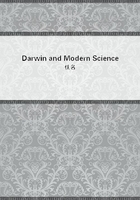
第181章
Pleading for a few primary centres he accepts Sclater's six regions and does not follow Huxley's courageous changes which Sclater himself had accepted in 1874. Holding the view of the permanence of the oceans he accounts for the colonisation of outlying islands by further elaborating the views of Lyell and Darwin, especially in his fascinating "Island Life", with remarkable chapters on the Ice Age, Climate and Time and other fundamental factors. His method of arriving at the degree of relationship of the faunas of the various regions is eminently statistical. Long lists of genera determine by their numbers the affinity and hence the source of colonisation. In order to make sure of his material he performed the laborious task of evolving a new classification of the host of Passerine birds. This statistical method has been followed by many authors, who, relying more upon quantity than quality, have obscured the fact that the key to the present distribution lies in the past changes of the earth's surface. However, with Wallace begins the modern study of the geographical distribution of animals and the sudden interest taken in this subject by an ever widening circle of enthusiasts far beyond the professional brotherhood.
A considerable literature has since grown up, almost bewildering in its range, diversity of aims and style of procedure. It is a chaos, with many paths leading into the maze, but as yet very few take us to a position commanding a view of the whole intricate terrain with its impenetrable tangle and pitfalls.
One line of research, not initiated but greatly influenced by Wallace's works, became so prominent as to almost constitute a period which may be characterised as that of the search by specialists for either the justification or the amending of his regions. As class after class of animals was brought up to reveal the secret of the true regions, some authors saw in their different results nothing but the faultiness of previously established regions; others looked upon eventual agreements as their final corroboration, especially when for instance such diverse groups as mammals and scorpions could, with some ingenuity, be made to harmonise.
But the obvious result of all these efforts was the growing knowledge that almost every class seemed to follow principles of its own. The regions tallied neither in extent nor in numbers, although most of them gravitated more and more towards three centres, namely Australia, South America and the rest of the world. Still zoologists persisted in the search, and the various modes and capabilities of dispersal of the respective groups were thought sufficient explanation of the divergent results in trying to bring the mapping of the world under one scheme.
Contemporary literature is full of devices for the mechanical dispersal of animals. Marine currents, warm and cold, were favoured all the more since they showed the probable original homes of the creatures in question. If these could not stand sea-water, they floated upon logs or icebergs, or they were blown across by storms; fishes were lifted over barriers by waterspouts, and there is on record even an hypothetical land tortoise, full of eggs, which colonised an oceanic island after a perilous sea voyage upon a tree trunk. Accidents will happen, and beyond doubt many freaks of discontinuous distribution have to be accounted for by some such means.
But whilst sufficient for the scanty settlers of true oceanic islands, they cannot be held seriously to account for the rich fauna of a large continent, over which palaeontology shows us that the immigrants have passed like waves. It should also be borne in mind that there is a great difference between flotsam and jetsam. A current is an extension of the same medium and the animals in it may suffer no change during even a long voyage, since they may be brought from one litoral to another where they will still be in the same or but slightly altered environment. But the jetsam is in the position of a passenger who has been carried off by the wrong train. Almost every year some American land birds arrive at our western coasts and none of them have gained a permanent footing although such visits must have taken place since prehistoric times. It was therefore argued that only those groups of animals should be used for locating and defining regions which were absolutely bound to the soil.
This method likewise gave results not reconcilable with each other, even when the distribution of fossils was taken into account, but it pointed to the absolute necessity of searching for former land-connections regardless of their extent and the present depths to which they may have sunk.